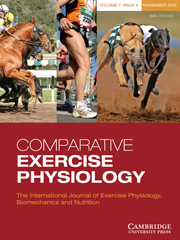Crossref Citations
This article has been cited by the following publications. This list is generated based on data provided by
Crossref.
dos Reis, Ivan Gustavo Masselli
de Araujo, Gustavo Gomes
and
Gobatto, Claudio Alexandre
2010.
Maximal lactate steady state in swimming rats by a body density-related method of workload quantification.
Comparative Exercise Physiology,
Vol. 7,
Issue. 04,
p.
179.
de Barros Manchado-Gobatto, F.
Gomes de Araujo, G.
Ribeiro, C.
Barbosa Araújo, M.
Soares de Alencar Mota, C.
Alexandre Gobatto, C.
and
Rostom de Mello, M.A.
2012.
Effects of light-dark cycle manipulation on critical velocity and anaerobic running capacity in Wistar rats.
Comparative Exercise Physiology,
Vol. 8,
Issue. 1,
p.
71.
Costa Júnior, José M.
Rosa, Morgana R.
Protzek, André O.
de Paula, Flávia M.
Ferreira, Sandra M.
Rezende, Luiz F.
Vanzela, Emerielle C.
Zoppi, Cláudio C.
Silveira, Leonardo R.
Kettelhut, Isis C.
Boschero, Antonio C.
de Oliveira, Camila A. M.
and
Carneiro, Everardo M.
2015.
Leucine supplementation does not affect protein turnover and impairs the beneficial effects of endurance training on glucose homeostasis in healthy mice.
Amino Acids,
Vol. 47,
Issue. 4,
p.
745.
Rodrigues, Natalia Almeida
Torsoni, Adriana Souza
Fante, Thais
dos Reis, Ivan Gustavo Masselli
Gobatto, Claudio Alexandre
and
Manchado-Gobatto, Fúlvia Barros
2017.
Lactate minimum underestimates the maximal lactate steady-state in swimming mice.
Applied Physiology, Nutrition, and Metabolism,
Vol. 42,
Issue. 1,
p.
46.
DONG, F.
LIU, Y.
ZHANG, Z.
GUO, R.
MA, L.
QU, X.
YU, H.
FAN, H.
and
YAO, R.
2017.
Postnatal Alteration of Monocarboxylate Transporter 1 Expression in the Rat Corpus Callosum.
Physiological Research,
p.
345.
Nogueira, Pedro Augusto Silva
Pereira, Miriam Pimenta
Soares, Jeferson José Gomes
de Assis Silva Gomes, Juliana
Ribeiro, Daniele Lisboa
Razolli, Daniela Soares
Velloso, Licio Augusto
Neto, Morun Bernardino
and
Zanon, Renata Graciele
2020.
Swimming reduces fatty acids-associated hypothalamic damage in mice.
Journal of Chemical Neuroanatomy,
Vol. 103,
Issue. ,
p.
101713.
Kraemer, Maurício Beitia
Silva, Karen Christine
Kraemer, Camila Cunha França
Pereira, Juliana Silva
dos Reis, Ivan Gustavo Masseli
Priolli, Denise Gonçalves
and
Messias, Leonardo Henrique Dalcheco
2022.
Validity of the peak velocity to detect physical training improvements in athymic mice.
Frontiers in Physiology,
Vol. 13,
Issue. ,
Pelosi, Andrea Corazzi
Scariot, Pedro Paulo Menezes
Garbuio, Ana Luíza Paula
Kraemer, Maurício Beitia
Priolli, Denise Gonçalves
Masselli dos Reis, Ivan Gustavo
and
Messias, Leonardo Henrique Dalcheco
2023.
A systematic review of exercise protocols applied to athymic mice in tumor-related experiments.
Applied Physiology, Nutrition, and Metabolism,
Vol. 48,
Issue. 10,
p.
719.
Orsi, Juan B.
Araujo, Lara S.
Scariot, Pedro P. M.
Polisel, Emanuel E. C.
Cardoso, Luisa O.
Gobatto, Claudio A.
and
Manchado-Gobatto, Fúlvia B.
2023.
Critical Velocity, Maximal Lactate Steady State, and Muscle MCT1 and MCT4 after Exhaustive Running in Mice.
International Journal of Molecular Sciences,
Vol. 24,
Issue. 21,
p.
15753.


